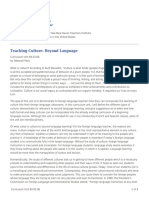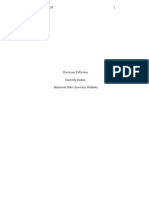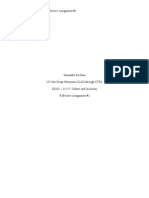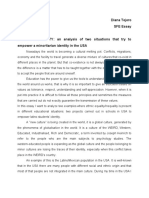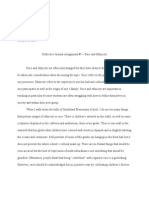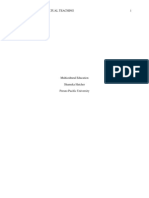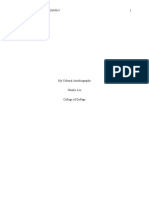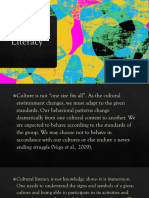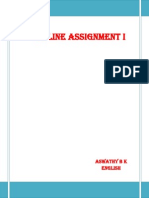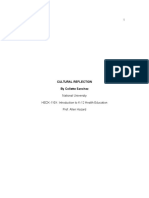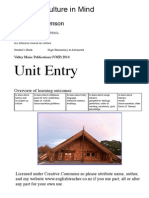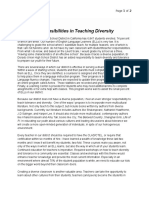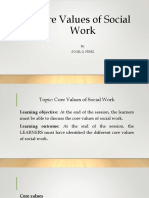Erin Lawson Diversity Audit 1
Erin Lawson Diversity Audit 1
Uploaded by
api-738338377Copyright:
Available Formats
Erin Lawson Diversity Audit 1
Erin Lawson Diversity Audit 1
Uploaded by
api-738338377Original Title
Copyright
Available Formats
Share this document
Did you find this document useful?
Is this content inappropriate?
Copyright:
Available Formats
Erin Lawson Diversity Audit 1
Erin Lawson Diversity Audit 1
Uploaded by
api-738338377Copyright:
Available Formats
Erin Lawson Diversity Audit
First, culturally responsive teaching requires an educator to be capable of several things,
no matter their cultural background: empathy, risk-taking, self-reflection, flexibility, and having
a student-centered attitude. Each teacher, just like each student, comes from a different set of
background experiences, and the teacher must understand that his/her personal opinions and
perceptions are limited. For example, an educator’s decision to self-censor by avoiding a
specific book in class could be rooted in personal biases and have long-term negative
consequences on students.
In a previous experience at a different school than where I currently work, the
environment was definitely at a level one: the contribution stage. The only time diversity
seemed to be not really celebrated, but incorporated in any way, was during Black History
Month, and only in the most superficial and stereotypical ways (upsetting as a majority of the
students were black). In addition to this, black culture was the only varying/diverse culture that
was exhibited by any attempts. This was distressing because we also had quite a population of
Hispanic students, Asian students, and even a small group of Indian students who spoke no
English when they suddenly immigrated and began school at that district during their middle
school years. I remember struggling to connect, communicate, and find resources/support for my
student in the Hindi language when she first arrived, and no one seemed interested in helping me.
I still feel guilty at how her education had to have suffered and how much better her experience
could have been (as well as her classmates who could have had such a great opportunity for
exposure), especially having my current school to compare this all to.
The lack of diversity and cultural awareness didn’t stop at ELLs and the cultural
competence of the district as a whole. There were other incidents that were distressing to
witness. A small group of students confided to the art teacher that they were experiencing
bullying and hatred as a response to their sexual orientation and/or gender identity. The art
teacher decorated her door with rainbow stripes that appeared to “drip” from paint buckets at the
top; she also included inspirational quotes on the outside about being and loving yourself, as well
as factual statistics about things like middle school students and gender identity, percentages
about bullying, etc. Administration immediately asked her to take it all down, and when she
defended it, she was reprimanded, written up, and given a warning that she would be on
probation if she did not take it down.
I believe my current school sits at a level three: the transformational stage. Not only is
our library completely remodeled to be more accessible to students, but also to allow for a
diverse selection of literature of every kind (even being aware of some texts that are intended to
be culturally diverse, but having that “white savior” character). If there is a day, week, or month
that celebrates any person or culture that may be represented within our school, the school
acknowledges and celebrates it however it can (not just talking about it on the announcements,
but sharing on social media, talking about it during morning meetings, making cards or doing
projects for the celebration, etc.). Even in classroom instruction at the elementary level, I have
already seen culturally responsive teaching. Texts selected are often authentic and reflect a
variety of cultures and perspectives. The whole overall culture of this school is so inclusive that
Erin Lawson Diversity Audit
students actually get excited about learning anything outside of their own experiences and
background knowledge: I have students thrilled to be teaching themselves sign language,
students learning the Spanish words for the lunch choices offered daily (I have 2 Spanish
speaking ELL students in my homeroom), students eager to see more Chinese poetry written in
calligraphy (and try to write their own), and more.
I think the biggest example is my students from Ukraine. I have two students in my 3rd
grade homeroom class who are Ukrainian refugees. When they first came, they had nothing and
were missing family members and facing extreme trauma. They spoke no English. The way the
whole school community has come together for them has been astounding. So many students in
my class have gone home daily trying to practice Ukrainian on DuoLingo so that they could
make the girls feel welcome. We are sure to include them on our science, social studies, and
math instruction on-grade level, with supports to help them understand. Every special event the
school hosts, we include activities or crafts that would remind them of home and teach other
students about their culture.
If I could do one thing to move me or my school up a level on the continuum of cultural
competency, it would be to include more hands-on, inquiry-based learning projects for our 3rd
and 4th graders. This could easily be done in our social studies courses when we talk about
community. Often, we have the students focus on the school community on a basic level (what
are the expectations, how can we be respectful, etc.). I think we could dig even deeper and help
students to see what problems may exist within the classroom, school, and/or community, and
guide them towards being able to research and understand/explain the problem, then take it a step
further by coming up with solutions and action-based approaches (example problems could be
lack of public parks in the town, fundraising for the public library, or how to get more
parents/families involved and connected at school).
You might also like
- Say Their Names Unit Plan - The Hate U Give100% (2)Say Their Names Unit Plan - The Hate U Give40 pages
- Jennifer Kang - Student Teaching AutobiographyNo ratings yetJennifer Kang - Student Teaching Autobiography5 pages
- Acharya Nagarjuna University: No - ANU/B.Ed. Exams/Percentage/2021 Date: 30-09-2021. To Whomsoever It May ConcernNo ratings yetAcharya Nagarjuna University: No - ANU/B.Ed. Exams/Percentage/2021 Date: 30-09-2021. To Whomsoever It May Concern1 page
- Growing Up in Transit: The Politics of Belonging at an International SchoolFrom EverandGrowing Up in Transit: The Politics of Belonging at an International SchoolNo ratings yet
- Multiculturalism in Education Philosophy StatementNo ratings yetMulticulturalism in Education Philosophy Statement7 pages
- A Reflection On Closing The Culture Gap Commentary by Tim Walker Melissa Erickson Winona State University Rochester, MinnesotaNo ratings yetA Reflection On Closing The Culture Gap Commentary by Tim Walker Melissa Erickson Winona State University Rochester, Minnesota4 pages
- Building and Enhancing New Literacies Across The Curriculum: Pedro Rebadulla Memorial CampusNo ratings yetBuilding and Enhancing New Literacies Across The Curriculum: Pedro Rebadulla Memorial Campus21 pages
- Creating A Culture Friendly EnvironmentNo ratings yetCreating A Culture Friendly Environment12 pages
- The Importance of Multicultural LiteracyNo ratings yetThe Importance of Multicultural Literacy2 pages
- BV-TRA-EDU-Using Translation Theory To Help Inform Teaching in An ESL SettingNo ratings yetBV-TRA-EDU-Using Translation Theory To Help Inform Teaching in An ESL Setting124 pages
- Don't Speak Spanish! Just Three Words and Their Harmful Impact at Two Texas Middle SchoolsFrom EverandDon't Speak Spanish! Just Three Words and Their Harmful Impact at Two Texas Middle SchoolsNo ratings yet
- Multicultural Literature - The Impact It Has On Todays StudentsNo ratings yetMulticultural Literature - The Impact It Has On Todays Students69 pages
- Culture Inclusion Reflective Assignment 2 - BecharaNo ratings yetCulture Inclusion Reflective Assignment 2 - Bechara5 pages
- Multiculturalism in Education: Diana Vargas, Cesar Batiz, Adriana Covarrubias, Jackie Hernandez, Daisy ReyesNo ratings yetMulticulturalism in Education: Diana Vargas, Cesar Batiz, Adriana Covarrubias, Jackie Hernandez, Daisy Reyes27 pages
- Development of Socio-Cultural Identity at Primary School Children Through School ProjectsNo ratings yetDevelopment of Socio-Cultural Identity at Primary School Children Through School Projects5 pages
- 2 Grade Interdisciplinary African and African American Studies Quarter 3 Launch LessonNo ratings yet2 Grade Interdisciplinary African and African American Studies Quarter 3 Launch Lesson4 pages
- Cultural Literacy and Multicultural LiteracyNo ratings yetCultural Literacy and Multicultural Literacy25 pages
- The Effects of Multicultural Literature in The ClassroomNo ratings yetThe Effects of Multicultural Literature in The Classroom41 pages
- You (2006), "Culture Is The Totality of Ideas, Beliefs, Values, Activities, andNo ratings yetYou (2006), "Culture Is The Totality of Ideas, Beliefs, Values, Activities, and8 pages
- Cultural Diversity Research Project and ReflectionNo ratings yetCultural Diversity Research Project and Reflection7 pages
- Hedx1101 C Sanchez Unit2 Culturalreflection Dec2014No ratings yetHedx1101 C Sanchez Unit2 Culturalreflection Dec20148 pages
- Keeping Culture in Mind Entry Unit (May30 2014)100% (1)Keeping Culture in Mind Entry Unit (May30 2014)11 pages
- 3 Reflect ResponsibiltiesinteachingdiversityNo ratings yet3 Reflect Responsibiltiesinteachingdiversity2 pages
- Color Expressions: an Art Educational Voyage: An Art Educational VoyageFrom EverandColor Expressions: an Art Educational Voyage: An Art Educational VoyageNo ratings yet
- Teaching Cross-Culturally: An Incarnational Model for Learning and TeachingFrom EverandTeaching Cross-Culturally: An Incarnational Model for Learning and Teaching4/5 (7)
- Text Set Erin Lawson Line of Inquiry Traditional BooksNo ratings yetText Set Erin Lawson Line of Inquiry Traditional Books5 pages
- Annotated-Lawson 20bda 20lesson 20plan 20egyptNo ratings yetAnnotated-Lawson 20bda 20lesson 20plan 20egypt5 pages
- Lesson Plan - Meat Inspection and The JungleNo ratings yetLesson Plan - Meat Inspection and The Jungle3 pages
- Human Resource Management: Comprehensive Study Program To Adopt Management Information System (MIS)No ratings yetHuman Resource Management: Comprehensive Study Program To Adopt Management Information System (MIS)10 pages
- Mitch Fryling & Linda Hayes - An Interbehavioral Investigation of Remembering InteractionsNo ratings yetMitch Fryling & Linda Hayes - An Interbehavioral Investigation of Remembering Interactions11 pages
- Critically Evaluate The Application of Leadership Theories To A Leader in An Organisational ContextNo ratings yetCritically Evaluate The Application of Leadership Theories To A Leader in An Organisational Context8 pages
- Department of Examinations, Sri Lanka.: Official Use OnlyNo ratings yetDepartment of Examinations, Sri Lanka.: Official Use Only6 pages
- Brownie Bits A3 Grade Lesson Study On The Distributive PropertyNo ratings yetBrownie Bits A3 Grade Lesson Study On The Distributive Property10 pages




















